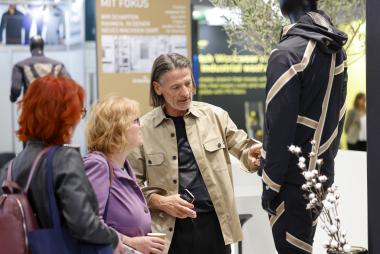A+A 2025 hat begonnen
Die A+A 2025 hat begonnen und verwandelt Düsseldorf in das Zentrum der internationalen Welt des Arbeitsschutzes. Unter dem Leitthema „Der Mensch zählt“ vereint die Weltleitmesse für Arbeitsschutz, Arbeitssicherheit und Gesundheit bei der Arbeit mehr als 2.340 Ausstellende aus 70 Ländern auf 88.500 Nettoquadratmetern in 13 Messehallen und wird damit erneut zum Treffpunkt der internationalen Fachcommunity für die Zukunft der Arbeit.
Die A+A verbindet Innovationskraft mit fachlichem Austausch auf höchstem Niveau. Sie kombiniert die weltweit führende Fachmesse mit einem hochkarätigen Kongress, der praxisnahes Know-how mit neuesten wissenschaftlichen Erkenntnissen verbindet. So setzt sie Impulse für die sichere, gesunde und nachhaltige Arbeitswelt der Zukunft.
Mit ihren Schwerpunkten Persönliche Schutzausrüstung (PSA), Workwear, dem EXO PARK für Robotik und Exoskelette, Fire Protection & Emergency Management sowie der Start-up Zone des BMWE (Bundesministerium für Wirtschaft und Energie) präsentiert die A+A das gesamte Spektrum für Sicherheit, Gesundheit und Schutz am Arbeitsplatz.
„Die A+A steht für Internationalität, Innovation und erfolgreiches Business. Sie ist ein Ort, an dem Innovationen sichtbar werden, wertvolle Geschäftskontakte entstehen und sich Netzwerke vertiefen. Mit der A+A und unserem internationalen Portfolio im Bereich Occupational Safety and Health bieten wir Plattformen, auf denen Märkte, Marken und Menschen gemeinsam die Zukunft der Arbeit gestalten“, erklärt Marius Berlemann, Geschäftsführer der Messe Düsseldorf.
Erleben, was die Zukunft der Arbeit sicherer und smarter macht
Von smarten Tools und Virtual Reality bis zu innovativer Workwear und PSA – die A+A 2025 zeigt eindrucksvoll, wie Technologie, Nachhaltigkeit und Design die Arbeitswelt von morgen prägen. Im EXO PARK in Halle 5 erleben Teilnehmende, wie Exoskelette und digitale Ergonomie-Tools echte Veränderung in der Arbeitswelt bewirken. Hersteller von industriellen Exoskeletten präsentieren ihre Systeme zum Ausprobieren live vor Ort – eine seltene Gelegenheit für eine direkte Anwendungserfahrung und direkten Blick hinter die Technologie.
Ein besonderes Highlight innerhalb des EXO PARKs ist die Exoworkathlon-Live-Studie des Fraunhofer IPA: Auf realen Parcours können Teilnehmende erfahren, wie Exoskelette körperliche Belastungen reduzieren, Bewegungsabläufe optimieren und damit einen wichtigen Beitrag zu Gesundheit, Effizienz und Sicherheit am Arbeitsplatz leisten.
Auch im Bereich Persönliche Schutzausrüstung (PSA) und Workwear überzeugt die A+A 2025 mit Innovationen: Leichte Sicherheitsschuhe, solarbetriebene Gehörschutzsysteme, intelligente Atemschutzgeräte oder Grip-revolutionierende Sohlen machen Fortschritt greifbar. Auf der Fashion Show Bühne in Halle 15 wird Workwear mit einer neuen Ästhetik aus Sicherheit, Komfort und Markenbewusstsein zum Erlebnis. So zeigt die A+A 2025 eindrucksvoll, wie Zukunft gestaltet wird – smart, sicher und nachhaltig.
Wissen neu erleben – praxisnah, interaktiv, zukunftsweisend
Der 39. A+A Kongress 2025 im Congress Center Düsseldorf Süd, der von der Bundesarbeitsgemeinschaft für Sicherheit und Gesundheit bei der Arbeit e.V (Basi) ausgerichtet wird, präsentiert sich mit frischen, praxisnahen Formaten. Im Mittelpunkt stehen die Auswirkungen des Klimawandels, psychische Gesundheit, wirksame Präventionsstrategien sowie die Rolle von Digitalisierung und Künstlicher Intelligenz im modernen Arbeitsschutz. Besonderes Augenmerk gilt kleinen und mittleren Unternehmen (KMUs), die im Kongress praxisrelevante Impulse erhalten. Erfolgreiche Mittelständler teilen ihre Erfahrungen und zeigen, wie sich Sicherheits- und Gesundheitsstrategien auch mit begrenzten Ressourcen wirkungsvoll umsetzen lassen – von Gefährdungsanalysen über nachhaltige PSA bis hin zu digitalen Lösungen für den Arbeitsalltag.
„Der Internationale Kongress für Arbeitsschutz und Arbeitsmedizin ist das Herzstück der A+A. Hier fließen wissenschaftliche Erkenntnisse, Praxis und politische Impulse für eine sichere und gesunde Arbeitswelt zusammen“, sagt Dr. Christian Felten, Geschäftsführer der Basi. „Der 39. A+A Kongress 2025 steht für Prävention, Nachhaltigkeit und die Chancen digitaler Transformation im Arbeitsschutz“, so Felten weiter.
Ein weiteres Highlight der A+A ist die WearRAcon Europe in Halle 1, organisiert vom Fraunhofer IPA, dem IFF der Universität Stuttgart und der Wearable Robotics Association (USA). Die Fachkonferenz zu tragbarer Robotik ergänzt das Programm erneut um zukunftsweisende Impulse für Ergonomie, Prävention und Rehabilitation. Im Trend Forum in Halle 5 treffen Forschung und Praxis zusammen: Expertinnen und Experten präsentieren aktuelle Erkenntnisse, während Start-ups am BMWE YOUNG INNOVATORS-Stand zeigen, wie Innovation Sicherheit neu denkt – von KI-Assistenzsystemen und Prävention bis zu ergonomischen Tools und smarten Schutztextilien.
Das Deutsche Netzwerk Büro (DNB), das sich auch in Halle 5 befindet, präsentiert praxisnahe Konzepte für gesundes, hybrides Arbeiten. Gemeinsam mit dem Werkfeuerwehrverband werden in Halle 1 Live Demonstrationen moderner Sicherheitstechnologien geboten.
Messe Düsseldorf



























